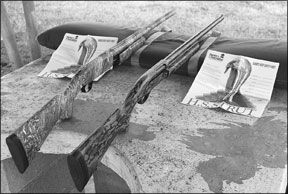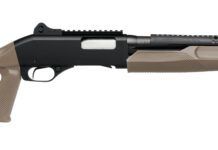Turkey hunting in most areas of the country is a sport that is heavy on stalking, concealment and calling to bring the big toms into effective scattergun range. All of that work can be for nothing if the shooting tool brought into play does not produce a killing pattern with the first shot or cannot provide a rapid, effective follow-up shot.
Testing a semiautomatic against a pump-action provided us with an interesting opportunity to see if there was a difference in ability to take a quick follow-up shot on a wounded turkey. In our timed tests with two targets attempted with two quick shots, we found there was virtually no difference in the follow-up shooting sequence. However, as noted in the individual reviews of each shotgun, we did find a difference in patterning performance.

As preliminary requirements for our turkey gun test, both shotguns had to be decked out in camouflage; both had to handle 3-inch shells; and both barrels had to accept screw-in chokes-a handy accessory for helping produce the best killing shot at normal turkey-hunting ranges.
We found a good match on the used gun rack at Durys Gun Shop in San Antonio, www.durysguns.com, with an older model Remington 11-87 semiautomatic and a fairly new version of the Browning BPS pump-action. Both shotguns also featured 26-inch barrels, which seem to be favored by turkey hunters who, in some situations, have to deal with close-quarter shooting conditions.
Another appreciated feature on both shotguns was sling attachments that permitted the installation of a carrying strap. Being able to carry the shotguns-heavier than typical scatterguns used for field work-with a sling over a shoulder would be a welcome benefit for a turkey hunter taking a long hike to an ambush site for big toms.
For the patterning tests, our ammunition included Remington Nitro Turkey 3-inch loads with 1 7/8 ounces of No. 4 lead shot and an average muzzle velocity of 1,210 fps; and Federal Premium Mag-Shok 3-inch loads with 2 ounces of No. 4 copper-plated shot and an average muzzle velocity of 1,300 fps. We also spent some familiarization time with the two shotguns at a five-stand course shooting Remington Premier STS Light Target 2.75-inch loads with 1 1/8 ounces of No. 8 shot and an average muzzle velocity of 1,145 fps. The patterning and handling performance are covered in the individual reviews of each shotgun.
Heres our test report:
Browning BPS Special Steel
12 Gauge Pump Action, $550
Other than the camo finish, the BPS was similar in configuration and price to the currently cataloged BPS Stalker No. 012212305, with a barrel length of 26 inches, nominal overall length of 46.75 inches, nominal length of pull of 14.25 inches, and a nominal weight of 8 pounds. It comes with Full, Modified, and Improved Cylinder chokes, a matte-black composite stock, and a U.S. suggested retail of $549. A closer match in terms of finish would be the BPS, Mossy Oak New Break-up BPS No. 012227305. It has a Dura-Touch Armor Finish on the wood and sells for $679.
Though pump-action shotguns are not normally associated with what some scattergun enthusiasts would call “proper balance,” we were pleasantly surprised with the overall handling ability of the Browning BPS. The balance point of the shotgun was just past the receiver and allowed the shooter to easily move the firearm into shooting position. This feature made the Browning feel more comfortable to shoot, both with stationary and moving targets.
As noted before, the weight of Browning that tipped the scales at 7.5 pounds was slightly heavy. We appreciated the weight, however, when shooting heavy turkey loads, and we did not suffer from recoil shock. There was no appreciable difference in the recoil between the Browning and the heavier gas-operated Remington, our testers said.
Dimensions of the Browning were found to be standard, with a drop at the comb of 1.5 inches and a drop at the heel of 2.5 inches. The length of pull was 14 inches and the overall length of the shotgun with its 26-inch barrels was 46.5 inches. We were a little concerned with the trigger pull of 6 pounds and would recommend a little gunsmith tweaking to drop the pull down to a more acceptable 4 pounds or so. A lighter touch off will allow for better shot control, particularly on stationary targets like a turkey.
On the patterning range, the Browning turned in a very nice performance with both the first shot and a rapid follow-up shot. Shooting at a Hunters Specialties Turkey Target from a sitting position at 30 yards, our testers used the Browning to place an average of 32 No. 4 pellets in the head and neck area with both brands of ammunition. The quick follow-up shot, even with having to work the pump action, produced an average of 18 pellets in the kill zone of the head and neck with both the Remington and Federal shells. The normally acceptable number of hits with turkey loads is at least five, according to the information printed on the targets.
When we switched to a 30-inch circle of patterning paper at the same range, the Brownings pattern was consistently about 60-40, with 60 percent above the center and 40 percent below. This type of pattern is excellent for a hunter wanting to keep shot out of the body of a bird and in the vital areas of the head and neck.
We also liked another feature that was unique with the pump-action shotgun-the ability to quietly and quickly unload a round from the chamber and replace it with a different shell. This procedure, which could not be completed with the semiautomatic without unloading the magazine, would allow a hunter to replace No. 4 shells with heavier No. 2 or larger shot should uncooperative big toms stay out of No. 4 shot range.
The better handling ability of the Browning became more evident on the five-stand field, where clay targets were smacked with authority. Once again, the recoil of target loads fired in the Browning was not a problem for any of our test shooters, and the smooth-handling pump-action worked well on both report and true pairs.
Working a pump-action shotgun might require a little thought and practice for some shooters, but we believe the Browning is worth the extra effort for a hunter looking for a quality turkey gun.
Remington Model 11-87 Special Purpose
12 Gauge Semiautomatic, $550
The closest gun in the existing Remington lineup that we found to our Special Purpose 12 gauge is a 28-inch Vent Rib 11-87 Sportsman Camo. It comes with a Modified Rem Choke tube, is clad in Mossy Oak New Breakup camo, measures 48 inches overall and weighs 8.25 pounds. The No. 29895 Sportsman has an MSRP of $867. The 20-gauge/26-inch-barrel unit No. 29917 measures 39 inches overall, weighs 7.25 pounds, and has the same MSRP.
Introduced to American shooters in 1987, this shotgun in various configurations has provided favorable performance in a variety of hunting and target situations during the past 21 years. Our test gun was manufactured in the 1990s, and based on its heft and smooth operation, had been a dependable workhorse for its former owner or owners.
Like the Browning, the shotgun was equipped with a 26-inch barrel that accepted screw-in chokes, and although the overall length was slightly shorter than the Browning at 45.75 inches, the weight difference was quite noticeable. Dimensions of the Remington were exactly the same as the Browning, with a drop at the comb of 1.5 inches, a drop at the heel of 2.5 inches, and a length of pull of 14 inches. At 8.25 pounds, we considered the Remington on the heavy side for a field gun and noted that the balance point was about in the middle of the forearm. This made the shotgun a little front heavy, and it did not have the smooth handling feel of the Browning.
As noted earlier, the extra weight in the Remington did not result in less perceived recoil from any of the test ammunition, although no test shooter was uncomfortable firing the turkey or target loads. We were particularly pleased with the trigger pull on the Remington, which touched off at exactly 4 pounds. This smooth and crisp trigger on the used shotgun most likely had been achieved by a trip or two to a gunsmith.
Other than the heft and balance concerns with the Remington, we were generally satisfied with its performance on both stationary and clay targets. On the patterning board, the Remington produced about a 50-50 pattern with the No. 4 shot on a 30-inch circle set at 30 yards. However, the potentially killing hits on the turkey targets were not quite as impressive as the Browning in both the first shot and follow-up shot tests. The average number of hits in the head and neck area of the target was 25 on the first shot and dropped down to 10 on the second shot. While better than the standard optimum performance (as stated in the target literature) of five hits, the Remington semiautomatic simply could not match the results of the Browning.
When attempting the clay targets, there was little difference in the performance of the Remington once our shooters adjusted to the handling of the front-heavy shotgun. We did note that the Remington ejected the turkey loads and target loads well away from the shooter and were pleased with the overall function of the semiautomatic.
0209-Browning-BPS-Special-Steel.pdf






























